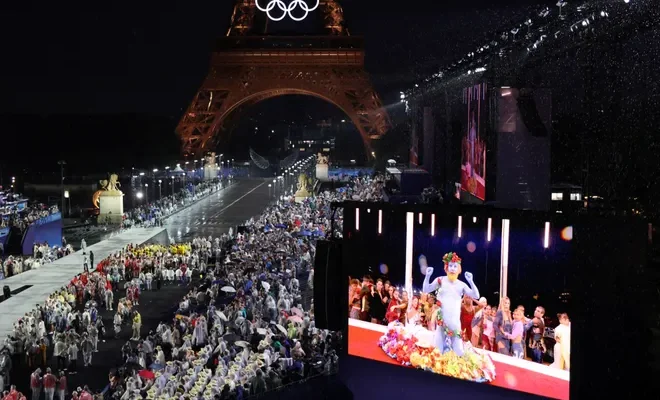Was the opening ceremony performance a mockery of Christianity, as some are suggesting? Or was it a homage to the Greek god Dionysus, as organizers proclaim?
Friday’s wild opening ceremony for the Paris Olympics put the spotlight on influential French metal bands, famed athletes bearing their nations’ flags and a triumphant return from Celine Dion herself.
The parade down the river Seine featured plenty of eye-catching moments that sparked online fervor – including one now particularly infamous scene that outraged many Christians who lambasted its resemblance to Leonardo Da Vinci’s famed Last Supper painting.
In the tableau, a scantily-clad man painted in blue emerged at the center of a table to sing among dancing drag queens.
Conservative and Christian leaders were quick to condemn the scene as an offensive parody of imagery and symbolism at the center of their faith, despite the insistence of ceremony organizers that they took inspiration from an ancient pagan festival.
So, was the brief scene a mockery of Christianity, as some are suggesting? Or was it a homage to the Greek god Dionysus, as organizers proclaim?
2024 Olympic medals: Who is leading the medal count? Follow along as we track the medals for every sport.
Here’s what to know about the controversial moment, and why some are questioning the performance’s intent.
Paris Olympics:Top moments from opening ceremony
Drag queens dance around Dionysus in opening ceremony performance
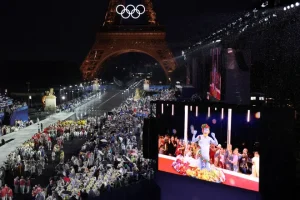
The performance featuring Dionysus was one of many highlights of the opening ceremony to this year’s summer Olympics taking place Friday on and along the Seine.
The tableau, which was broadcast during the ceremony, included a woman wearing a a silver, halo-like crown at the center of a long table flanked by drag queens. The scene is promptly disrupted when a nearly naked man painted blue emerges from a dinner plate surrounded by fruit.
As he begins singing, the drag queens break out into dance behind him.
Conservative, Christian leaders say performance mocked ‘Last Supper’
It wasn’t long until the scene prompted outcry from Christian and Conservative leaders in the United States who viewed its imagery as a mockery of “The Last Supper.”
The famous mural by Renaissance artist Leonardo da Vinci depicts Jesus Christ surrounded by his 12 apostles on the eve of his crucifixion.
As described in the Gospel, Jesus shares bread and wine with his gathered disciples, which he instructs them to eat and drink as his body and blood. The New Testament moment is a cornerstone of the Christian worship, as it is the basis of the Eucharist.
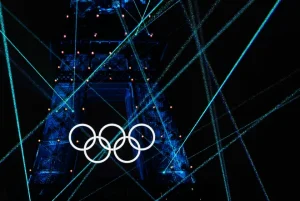
Because the Olympic opening ceremony scene so closely resembled the revered painting, several Christian and Catholic organizations publicly denounced it.
The French Bishops’ Conference, which represents the country’s Catholic bishops, said in a statement that the scene was a “mockery and derision of Christianity.” Influential American Catholic, Bishop Robert Barron of Minnesota, said in a video that it constituted a “gross mockery” of “a very central moment in Christianity.”
Conservative political leaders and businesses also criticized the piece.
In a post on X, formerly known as Twitter, House Speaker Mike Johnson (R-La.) on Saturday said the performance “was shocking and insulting to Christian people around the world.” C Spire, a U.S. telecommunications provider, also said on X that it was pulling its advertising from the Summer Games as a result of the performance.
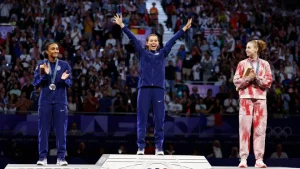
Who is Dionysus, reputed inspiration of ceremony feast scene?
But the opening ceremony’s artistic director, Thomas Jolly, has insisted that the scene is not a reference at all to the Last Supper.
Rather, the performance is a nod to a pagan celebration featuring Dionysus, the Greek god of fertility, wine and revelry.
Portrayed at the Olympics by French singer and actor Philippe Katerine, Dionysus – known to the Romans as Bacchus – has a close tie to France: In Greek mythology, he is the father of Sequana, the Goddess of the River Seine.
Even the official Olympics account on X said on Friday that the “interpretation of the Greek God Dionysus makes us aware of the absurdity of violence between human beings.” The post did not mention the Last Supper, while others commenting on the post described the performance as a depiction of a Dionysian feast.
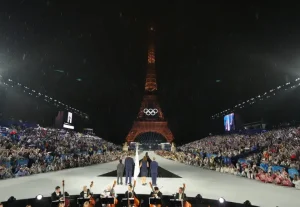
Following the outcry, Jolly said at the International Olympic Committee’s daily briefing at the Olympic Games on Saturday that the moment was not meant to “be subversive or shock people or mock people.” On Sunday, Jolly appeared on French TV station BFMTV to further insist that “The Last Supper” was “not my inspiration” for the segment.
“The idea was to have a pagan celebration connected to the gods of Olympus. You will never find in me a desire to mock and denigrate anyone,” he said. “The idea was to create a big pagan party in link with the God of Mount Olympus.”
What is the Festival of Dionysus?
In 5th century Athens, the Festival of Dionysus came to be one of the pinnacle events of the year.
Every year around springtime, playwrights would compete to entertain the masses of Athenian citizenry, according to Brown University. The festivities also included a procession from outside the city limits in which the sacred statue of Dionysus was carried to a theater named for the god near the Acropolis.
While the Olympic ceremony performance could be said to depict one such celebration, some have even said the scene was reminiscent of not just Da Vinci’s work, but other works as well.
Among them is “The Feast of the Gods,” a 17th century painting from Dutch artist Jan van Bijlert depicting the Greek gods of Olympus crowded around a long table. At the center of the table is the sun god Apollo, recognizable by a halo of light around his head.
The painting is among the collection at the Musée Magnin in Dijon, France, which posted images of it Sunday on X.
“Does this painting remind you of something?” the museum asked with a wink.
Ce tableau vous rappelle quelque chose ? 😉
Et si vous veniez l’admirer au #MuséenationalMagnin à Dijon ?@jeuxolympiques @paris2024@Thomajolly @DaphneBurki #Paris2024 #ceremoniedouverture #Jeuxolympiques pic.twitter.com/iUteobd2eb— Musée Magnin (@MagninMusee) July 28, 2024
Paris 2024 spokesperson issues apology
The explanations for the performance did not stop Paris 2024 spokesperson Anne Descamps from apologizing on Sunday to those offended by the scene.
“Clearly there was never an intention to show disrespect to any religious group. On the contrary, I think (with) Thomas Jolly, we really did try to celebrate community tolerance,” Descamps said. “Looking at the result of the polls that we shared, we believe that this ambition was achieved. If people have taken any offense, we are, of course, really, really sorry.”
The IOC said on social media that it took note of the apology from Paris 2024.
Contributing: Jordan Mendoza, USA TODAY
